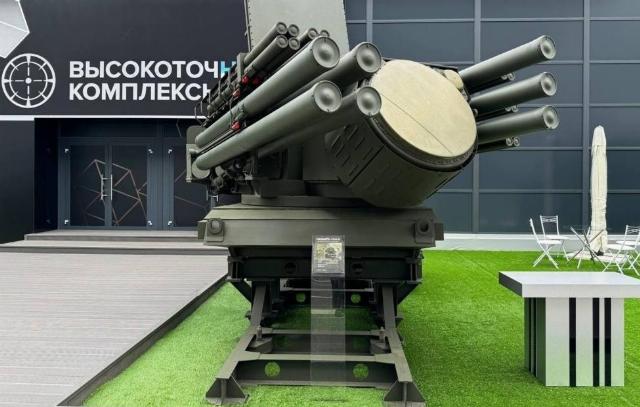Continuously developing unmanned systems, according to experts, have become the main threat on the modern battlefield. An inexpensive quadcopter is capable of hitting an expensive tank or radar, and even individual soldiers' movements will not hide from unmanned reconnaissance aircraft hanging in the sky. At the last Army-2024 forum, much attention was paid to the topic of protection against such systems. TASS gathered innovative anti-drone tools and talked with experts in the field of combating drones
Shoot down with a missile
A low-flying, small-sized unmanned aerial vehicle (UAV) is a difficult target for traditional air defense (air defense) systems. However, as the special operation has shown, Russian anti-aircraft missile systems successfully cope with such challenges, adapting to changing conditions. The latest modification of the famous Pantsir anti-aircraft missile and cannon complex, Pantsir-SMD—E, was presented at the Army-2024 forum. The novelty does not have cannon armament, like the basic version, but is capable of firing small-sized missiles designed to counter a massive drone attack. The Pantsir-SMD-E can be equipped with both longer-range standard missiles and blocks with four mini-missiles installed instead of standard ones. At the same time, the ammunition of the complex increases from 12 to 48 missiles.
"It is designed specifically for the protection of civilian, military facilities, administrative buildings, as the weight has been lightened, installation on the roofs of buildings for protection is possible," a representative of the Tula Instrument Engineering Design Bureau, the developer of the complex, said about Pantsir—SMD-E. "A special feature is remote control, which is handled by a single operator. It can be placed, for example, in a bunker, at a distance of up to 500 m, control is carried out via optical fiber," he added.
Another mobile development to combat UAVs is the Rapira—3 multifunctional complex based on the Spartak armored car. According to the information presented at the stand, the complex is capable of detecting ground and air targets using radar and an optoelectronic station, recognizing them and taking them on escort, and then destroying them with 80 mm missiles. The range of UAV damage is up to 4 km.
The Verba portable anti-aircraft missile system (MANPADS) is widely used by Russian troops to destroy air reconnaissance aircraft of the Armed Forces of Ukraine, as has been repeatedly reported by the Ministry of Defense of the Russian Federation. His missile has a unique homing head that "sees" the target immediately in the ultraviolet, near and middle infrared ranges. Thanks to this, the Willow detects even such "cold" targets as miniature drones equipped with electric motors emitting little heat.
Shoot down with a projectile
The forum demonstrated a promising 2C38 "Derivation" anti-aircraft artillery system designed to defeat drones with guided detonation projectiles. The 57-millimeter cannon is capable of sending a projectile at 9.5 km. In April of this year, Rostec State Corporation announced that they were doing everything to ensure that the novelty would be in the special operation zone as soon as possible.
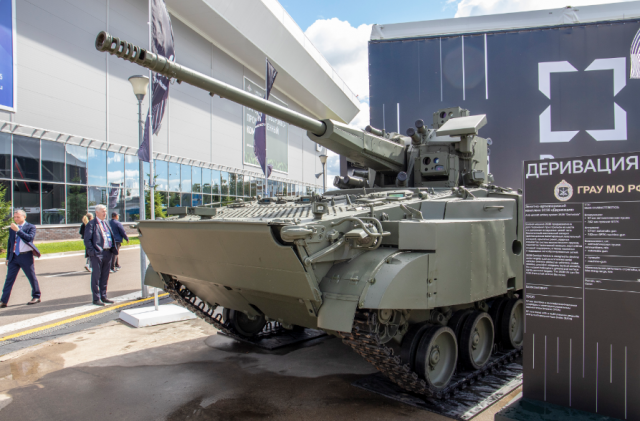 |
| 2C38 "Derivation". |
| Source: © Viktor Bodrov/ TASS |
In addition, a large number of cannon and machine gun systems - both new and upgraded — were presented at Army 2024 to combat drones. For example, JSC "STC ELINS" showed a Soviet 23-millimeter anti-aircraft gun, modified to combat small-sized drones. The complex, called ZU-23AE, has been retrofitted with a thermal imager, remote control, and it knocks down drones with projectiles with programmable air detonation. "A cloud of fragments is formed from the rupture of several ammunition, increasing the likelihood of hitting micro and mini UAVs, which are cheap and expensive to shoot at with large calibers and missiles. <...> The system is being tested at its landfill by the relevant services that participate in the SVO," Vladimir Ukhandeev, first Deputy chief designer of the company, told TASS, adding that there is a request for the system from the SVO zone and it is currently being tested.
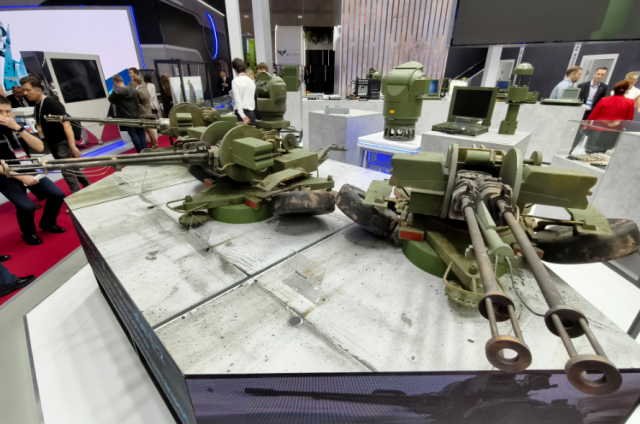 |
| ZU-23AE. |
| Source: © Viktor Bodrov/ TASS |
If the drone manages to get past the air defense systems, the near line of defense enters the battle. The special operation showed that an effective way to destroy FPV drones at short range is a smoothbore hunting rifle that shoots shot. A cloud of lead balls confidently hits a plastic drone, the main thing is to be able to get into it. To do this, military personnel actively train to shoot down air targets with multi-shot guns before being sent to the zone of their own. At the stand of the military innovative technopolis Era, a device was presented that turns a submachine gun grenade launcher into a single-shot 12-gauge shotgun. The cartridge is inserted into a special element, which in turn is installed instead of a grenade launcher shot. Thus, it is possible to shoot down a small drone at a distance of up to 50 m.
Mute
Modern UAVs are controlled and transmit the image from the on-board camera over the radio channel. These signals can be detected and suppressed by electronic warfare (EW), while the drone loses control, and its operator "goes blind". Large attack drones and cruise missiles (which are technically also kamikaze drones) are programmed to hit targets with known coordinates, guided in flight by signals from satellite navigation systems. Their frequencies can also be jammed, and the drone will lose its route and fall. Russian developers have created a large number of electronic warfare systems — from powerful stationary to wearable ones that fit in a fighter's pocket. An example of a "personal jammer" is the Meerkat mobile drone detection and suppression system presented at Army 2024. It consists of a detection module, a suppression module and a battery. They have a mass of 2.75 kg and are easily placed in the unloading system of a serviceman. The product detects an enemy "bird" at a range of at least 1 km and suppresses its operation at a distance of 300 m.
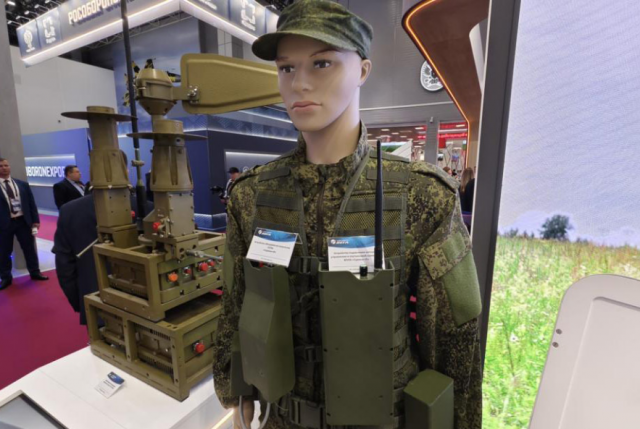 |
| The Meerkat portable FPV drone detection and Suppression kit. |
| Source: © Viktor Bodrov/ TASS |
Roselektronika Holding (part of Rostec) continues to develop the Sickle electronic suppression system to combat UAVs. The first option was announced by the state corporation within the framework of the Army-2018 forum. This year, the designers showed its newest version, the Sickle VS6D. It includes a high-precision detector and an electronic warfare system. The complex operates at the maximum number of frequencies, is effective against single drones and a swarm of UAVs, and instant digital signal processing algorithms minimize errors in operation. Sickles are already standing guard over Russian enterprises, including facilities of the military-industrial complex.
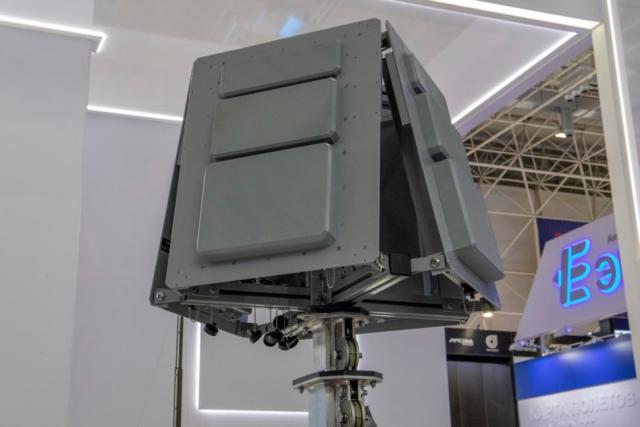 |
| The system of electronic suppression of small UAVS "SICKLE-VS5". |
| Source: Viktor Bodrov/ TASS |
A complex combining several methods of detecting and defeating enemy drones was presented at the forum. The Combat Antidron, shown at the stand of the Astron Aero Design Bureau, operates on the principle of layered defense. The radar station detects aerial targets at a distance of up to 5 km and includes an electronic warfare system. If the target continues to fly, the subsystem is activated, which determines the type of threat by sound. Then an optoelectronic station enters the battle, capturing the image of the target. She commands interceptor drones of various types. A prototype is presented at the stand that hits a UAV with a battering ram, but reusable interceptors can be used that neutralize the target with a shot or a net. It is planned that the Combat Antidron will be presented to the Ministry of Defense of the Russian Federation for testing in September this year.
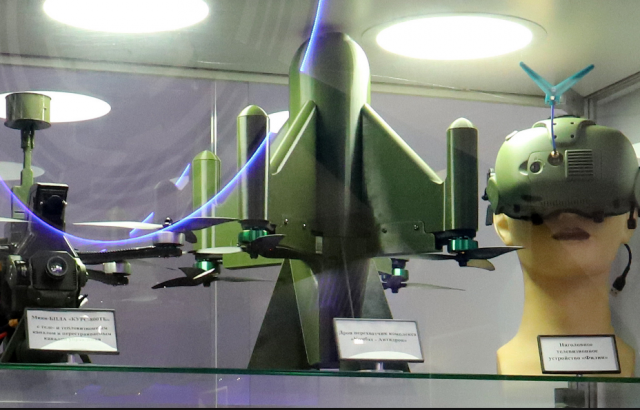 |
| An interceptor drone from the Kombat-Antidron complex. |
| Source: © Viktor Bodrov/ TASS |
The PPSH Laboratory company showed a crawler jamming robot "Rabovets Wall-e" at Army-2024. It carries protection modules against FPV drones and other UAVs and is designed to cover the work of assault groups, protecting them from attacks from the air. Among the products shown by the company are radio suppression modules designed for certain radio frequency ranges. Denis Oslomenko, CEO of the company, in an interview with TASS during the forum, noted that one of the main challenges for modern electronic warfare specialists in a special military operation is to increase the number of frequencies used by drones. "If a year ago we were working in a limited frequency spectrum, [then] now it is from 200 to 1,100 [MHz] via the drone control channel," he said. — Accordingly, the challenge for us is to close everything. Of course, this is a large number of modules, if we are talking about effective counteraction to FPV[drones]. Unfortunately, this will not be possible with a single broadband module. But we will come to the point where 12 modules will close these frequencies."
 |
| "Reb Wall-e". |
| Source: © Viktor Bodrov/ TASS |
Oslomenko suggested that the enemy would soon begin using higher frequencies, however, counteraction systems already exist for them. The General Director of the PPSH Laboratory expressed the opinion that the company will come to the development of electronic warfare systems with intelligent detection of the frequency range at which the enemy drone operates and selective activation of the necessary suppression modules. "Since the frequency spectrum is very large, turning on everything at once is a big energy consumption," he said. "Not every vehicle or armored vehicle will be able to provide this."
Also, the head of the "PPSH Laboratory" suggested that in the future there will be UAVs with artificial intelligence to capture and track a target before it is destroyed, while electronic suppression will become useless. "That is, he does not need a control channel, he captures the target and is already flying," he commented. However, according to him, these developments are quite crude both for Russian designers and their foreign opponents. "If we move to capture a target, then the task of electronic warfare is to suppress it when it has not yet captured it," Oslomenko said. — If we manage to suppress it when it has not yet captured, it will not hit. But in fact, they are not working out [effectively] yet, 50-50. Some kind of smoke screen is all, he gets lost. <...> There are ideas of how to crush it all — earlier, with directional antennas to increase the distance [of suppression], not to let him capture [the target]. Work is underway, we understand where this is all going."
Victor Bodrov
